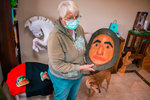
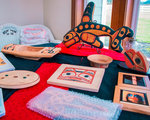
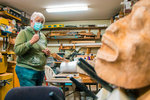
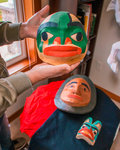
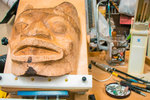
Editor’s Note:The Chronicle is working to assist local businesses suffering from the effects of the COVID-19 virus spread and associated government orders to close or limit commerce. There will be a feature on a local business in each edition of The Chronicle and at chronline.com moving forward. To be considered, email reporter Eric Trent at etrent@chronline.com. Additionally, The Chronicle will continue to offer its coverage of the coronavirus and its effects across the community, state and nation free outside of our paywall at chronline.com.
ONALASKA — One look at Tamara Hinck’s display of Native American-style wood carvings and one might think she’s been honing this craft her entire life. Turns out, she didn’t begin carving until after she retired in 2003.
Her husband asked her what she wanted to do with all her spare time. Hinck had always loved Northwest Coast Native art and wanted to try her hand at it. She found a teacher, Joe McConnell, a master carver from Sammamish, who she would drive to once a week from her home in Adna.
Hinck, like McConnell, is not Native American. There are a lot of non-Native carvers nowadays, Hinck said, and there seems to be two schools of thought on that. Some Native carvers resent non-Natives using traditions, protocol and culture. Many non-Natives make formline artworks, also known as Northwest Coast Native art, which is what Hinck specializes in.
Native art was nearly lost by the early- and mid-20th Century as the U.S. government outlawed potlatches until 1932, which meant Native communities were unable to practice traditional ceremonies. Even more, thousands of Native children were sent to assimilation boarding schools to strip them of their culture. One Canadian boarding school had a higher death rate than war zones.
Bill Holm, a white historian, author and artist, played a role in helping bring back Northwest Coast Native art awareness. His writing and teachings spread ideas that white institutions had tried to erase.
“Not to say people weren’t producing art all along, but they had lost the understanding that had built up over centuries,” Holm told Crosscut in 2014. “That went down the tube when they were suppressed at the beginning of the 20th century.”
Holm was not some white savior of Native art, however, it was the strength and resilience of Native communities, along with the American Indian Religious Freedom Act of 1978, that boosted cultural healing.
“Some Native carvers enjoy everybody sharing the art form,” Hinck said. “And some don’t. Some are very strict about it.”
Hinck wasn’t discouraged, however, walking a tightrope in respecting Native culture and traditions while also being careful not to step into cultural appropriation.
Her first piece was called ‘The First Project,’ which is a flat relief-carving of a bald eagle that is basic but has all the things a beginner needs to know. It’s the first style of carving she teaches newcomers.
She began drawing inspiration by visiting museums, attending carving shows, taking classes from master carvers and eventually entering carving shows. She went on to judge for ARTrails of Southwest Washington, a gallery in downtown Centralia. She has carved everything from masks to paddles to totem poles and 90 percent of her work is in the Northwest Coast Native-style.
Totem poles she has worked on are now displayed at numerous places in Washington state, including a 22-footer at Nisqually Middle School, one at the Squaxin Island Museum, a commissioned pole for Roy Wilson of the Cowlitz Indian Tribe and two others for friends in Winlock and Centralia.
There are rigid rules, color schemes and shapes that govern Northwest Coast Native art. Hinck tends to shift more specifically toward Tlingit and Haida Indian Tribes of Alaska, located on the Southwest Alaskan and Northwest British Columbian coast.
The types of wood she uses are old-growth cedar, yellow cedar and alder, her favorite being old-growth cedar with 25-or-more grains per inch, which is very difficult and rare to find in 2020.
Her favorite aspects of woodcarving are broken up into two parts.
“One is finding the design; that’s always exciting,” Hinck said. “The second is when it’s done and you look at it and go, ‘That’s not too bad.’”
Hinck’s artwork can be found at both her website (myfavoritewood.com/home.html) and her Facebook page (facebook.com/MyFavoriteWood/posts_to_page). Commissions are welcome, she said, and each piece is discussed with the client to accommodate wall space, trim size and materials. The paint is acrylic and the piece is sealed for interior or exterior display.
“If a person sees something they really like, or a picture of something they like, I’m always open to commissions,” Hinck said. “That’s really kind of the funnest thing because I think about the person and how much they’re going to love it while I’m working on it.”
•••
Reporter Eric Trent can be reached at etrent@chronline.com. Visit chronline.com/business for more coverage of local businesses.